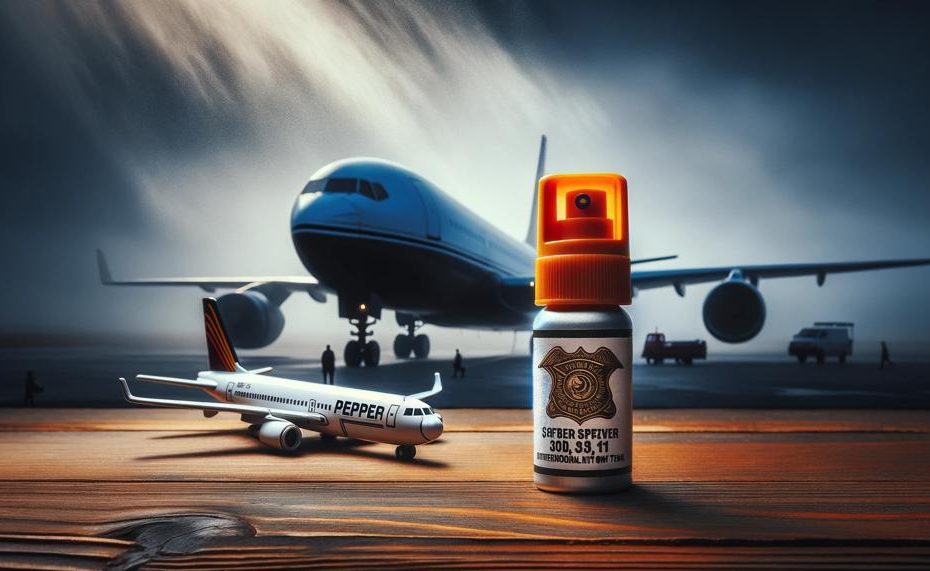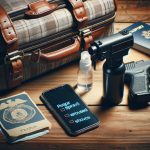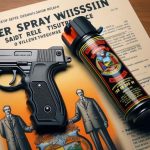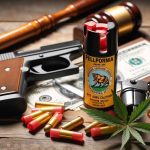When it comes to flying internationally, navigating the complex web of what you can and cannot bring on a plane is more intricate than a pilot’s pre-flight checklist. For those who prioritize personal safety, pepper spray often tops the list of travel must-haves. But will packing this small canister have you facing turbulence before you even take off?
In this blog post, we’re going to strip away the confusion and provide you with a clear flight path on the regulations surrounding pepper spray and international air travel. Forget vague advice and ambiguous guidelines; we’re here to deliver concrete information so you can pack with confidence and peace of mind.
So, can you bring pepper spray on an international flight?
The Transportation Security Administration (TSA) prohibits self-defense sprays with more than 2 percent by mass of tear gas (CS or CN) in checked baggage. This includes pepper spray, and some airlines may not allow it in checked bags. The TSA’s primary concern is that the spray could accidentally discharge in the plane’s cabin, causing health risks and chaos.
You also can’t carry pepper spray in your carry-on bag or personal item.
International aviation regulations (ICAO/IATA) also prohibit self-defense sprays in both carry-on and checked baggage.
You can bring a quart-sized bag of liquids, aerosols, gels, creams, and pastes in your carry-on bag, but these are limited to travel-sized containers that are 3.4 ounces (100 milliliters) or less per item.
So, buckle up and stow your tray tables because we’re about to take off into the world of personal safety in the skies—sans the clichés and overused phrases, promised.
Contents
- 1 Can you fly with pepper spray in your carry-on?
- 2 What Size Pepper Spray is Travel Size?
- 3 Can you take pepper spray abroad?
- 4 Is it illegal to carry pepper spray?
- 5 What self-defense weapons can you fly with?
- 6 Each of the major American Airlines answers: ‘Can You Fly With Pepper Spray?’
- 7 Does mace explode on a plane?
- 8 How to Travel with Pepper Spray
- 9 Best Pepper Sprays for Self Defense
- 10 Is it legal to take pepper spray onto an airplane?
- 11 Pepper Spray Regulations and Laws By State 2023
- 12 Conclusion
Can you fly with pepper spray in your carry-on?
No, you cannot fly with pepper spray in your carry-on baggage when travelling both domestically and internationally. Regulations are strict about self-defense sprays on commercial flights.
Understanding the Rules
Pepper spray, a common self-defense tool, is subject to stringent rules when it comes to air travel. Here’s the lowdown:
- Carry-On Bags: Totally off-limits. The restrictions are clear; no pepper spray up in the cabin.
- Checked Baggage: A wee bit more lenient. You can pack one 4 fl. oz. (118 ml) container of pepper spray in your checked luggage, provided it has a safety mechanism to prevent accidental discharge and contains no more than 2% tear gas by mass.
Table of Key Points
| Item | Carry-On | Checked Baggage |
| Pepper Spray | Not allowed | One 4 fl. oz. container with safety mechanism |
| Bear Spray | Not allowed | Not allowed |
What Size Pepper Spray is Travel Size?
When packing for an international flight, you’re allowed to bring a pepper spray canister in your checked baggage under specific conditions. The maximum size permitted is a 118 ml (4 fl. oz.) container.
However, it’s not just about size; the canister must also have a safety mechanism to prevent accidental discharge. Here’s a quick rundown of the requirements:
- Maximum Volume: 118 ml (4 fl. oz.)
- Safety Mechanism: Required to prevent accidental release
- Packaging: Must be in a secure container to prevent any leakage
- Declaration: You need to declare the item to the airline during check-in
- Legal Compliance: Always ensure that carrying pepper spray complies with the laws of both the departure and destination countries.
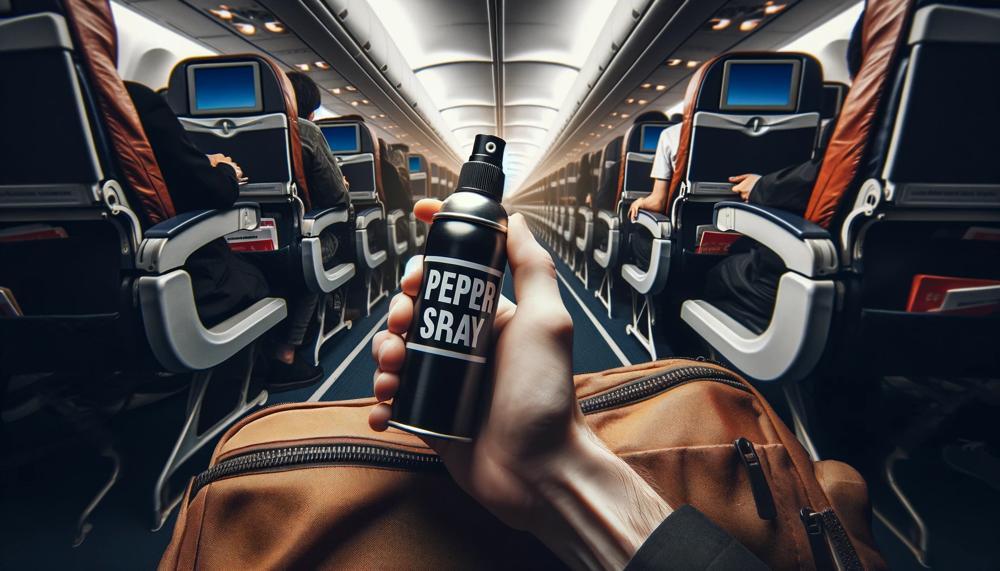
Here’s a tabular representation for clarity:
| Aspect | Requirement |
| Maximum Volume | 118 ml (4 fl. oz.) |
| Safety Mechanism | Essential |
| Packaging | Secure and leak-proof |
| Declaration | Mandatory at check-in |
| Legal Compliance | Check local laws |
Remember, it’s always a good idea to check directly with the airline, as individual carrier rules may vary slightly.
Can you take pepper spray abroad?
Pepper spray, a common self-defense tool, is subject to various regulations when traveling abroad, particularly when it comes to flights.
Key Restrictions for Checked Luggage
- Volume: Up to 4 fl. oz. (118 ml) per container.
- Safety Mechanism: Must include a mechanism to prevent accidental discharge.
- Tear Gas Limit: No more than 2 percent by mass (excludes Oleoresin capsicum).
Airline Policies and TSA Guidelines
Always verify with the specific airline for their policy as it may differ. Despite TSA’s allowance under stipulated conditions, an airline might impose stricter rules.
International Considerations
| Legality | Check if the country allows the importation and possession of pepper spray. |
| Local Regulations | Follow the country’s specific rules regarding defensive sprays. |
| Declaration | Declare the item to customs upon arrival if necessary. |
Usage and Transportation
While pepper spray can be a defensive measure, its capability to incapacitate makes it a no-go in the cabin of an aircraft. The risk of misuse, particularly in hijacking scenarios, outweighs its self-defense utility.
Remember, pepper spray is a controlled item and while you may be allowed to transport it under certain conditions in checked luggage, you should be aware of all regulations to avoid any trouble during your travels.
Is it illegal to carry pepper spray?
Carrying pepper spray for self-defense purposes is generally legal, but it is subject to various laws and restrictions which vary by country, state, and even local jurisdictions.
It’s crucial to be aware of the legalities in your specific location before acquiring or carrying pepper spray.
Regulations on International Flights
Bringing pepper spray onto an international flight involves adherence to strict rules. Below is a table detailing what is typically allowed:
| Item | Carry-on Baggage | Checked Baggage |
|---|---|---|
| Pepper Spray | Prohibited | Limited to one 4 fl. oz. (118 ml) container with a safety mechanism |
| Tear Gas Percentage | N/A | Must not exceed 2% |
| Bear Spray | Prohibited | Prohibited |
| Pepper Spray with Safety Switch | Prohibited | Allowed with restrictions |
Considerations for Travelers:
- Always check the TSA guidelines and consult airline policies before flying.
- Ensure your pepper spray has a safety switch to prevent accidental discharge.
- Be mindful that bear spray is not permitted on flights.
- If your keychain has pepper spray attached, it must go into checked baggage.
- Understand the laws of the destination country regarding pepper spray.
Remember, while you can transport a limited amount of pepper spray in checked baggage under certain conditions, never attempt to bring it in your carry-on.
What self-defense weapons can you fly with?
When it comes to flying internationally, the rules for self-defense weapons are quite stringent. Here’s a rundown of items you can have with you:
Noise Makers:
Personal alarms and whistles are generally permissible.
They can be used to attract attention and deter an assailant without posing a direct threat.
Tactical Pens and Flashlights:
These dual-purpose tools are often allowed.
A tactical pen is a writing instrument that can be used as a self-defense tool, and small flashlights can disorient an attacker while being practical for everyday use.
Self-Defense Keychains (Non-Weaponized):
These include keychains that do not feature sharp edges or points and are designed for striking an assailant in self-defense.
Safety Devices:
Personal safety alarms and locks that do not contain weapons are typically acceptable.
These items can secure your belongings and signal distress without being classified as weapons.
Service Animals:
While not weapons, service animals are allowed for individuals with disabilities. They provide support and protection but must meet specific airline and international regulations.
Below is a table summarizing what’s allowed and what’s not:
| Item | Allowed in Carry-on | Allowed in Checked Baggage |
| Noise Makers (Whistles, Alarms) | Yes | Yes |
| Tactical Pens | Yes | Yes |
| Small Flashlights | Yes | Yes |
| Self-Defense Keychains (Non-Weaponized) | Yes | Yes |
| Personal Safety Alarms/Locks | Yes | Yes |
| Service Animals | Yes (with restrictions) | Not applicable |
| Pepper Spray* | No | Limited (with restrictions) |
For pepper spray, check the airline’s policies and destination country’s regulations, as there are strict limitations and it’s often prohibited in carry-on and limited in checked baggage.
Always confirm with your airline and check the latest regulations before flying, as policies may change and can vary by carrier and country.
Each of the major American Airlines answers: ‘Can You Fly With Pepper Spray?’
Pepper spray carriage on international flights is tightly regulated. Here’s the lowdown on what major American Airlines say about flying with this self-defense item:
| Airline | Checked Baggage | Carry-On |
| American Airlines | Yes, max 4 fl. oz. with safety mechanism | No |
| Delta Air Lines | Yes, max 4 fl. oz. with safety mechanism | No |
| United Airlines | Yes, max 4 fl. oz. with safety mechanism | No |
| Southwest Airlines | Yes, max 4 fl. oz. with safety mechanism | No |
| JetBlue Airways | Yes, max 4 fl. oz. with safety mechanism | No |
| Alaska Airlines | Yes, max 4 fl. oz. with safety mechanism | No |
Remember, while the canister size and safety features are paramount, it’s also essential to check pepper spray’s expiry date—it usually ranges between 2 to 5 years.
Does mace explode on a plane?
The potential for mace, or pepper spray, to explode on a plane is tied to its pressurized container, which can be influenced by changes in cabin pressure and temperature. Yet, the term ‘explode’ might be a tad hyperbolic—it’s more accurate to say that these canisters may rupture or leak, rather than detonate dramatically.
In 2018, the TSA documented 48 incidents where pepper spray canisters leaked or discharged, likely due to pressure changes.
Regulations for Carrying Mace on Planes:
The Transportation Security Administration (TSA) stipulates that mace is permitted in checked luggage with restrictions:
- The pepper spray container must not exceed 4 fluid ounces (118 ml).
- The spray must contain less than 2% CS or CN tear gas.
- A safety mechanism to prevent accidental discharge is required.
Risks of Carrying Mace in Carry-On Bags:
- Potential to rupture: Due to changes in air pressure and temperature, the pressurized canister may leak or burst.
- Security concerns: Mace is considered a potential threat and may lead to confiscation and legal issues.
- Misidentification as a weapon: Could result in delays and further questioning by security personnel.
For your safety and the safety of others, it’s essential to follow these guidelines to the letter when considering traveling with mace.
Table of Mace Carrying Regulations and Risks:
| Item | Regulation | Risk if in Carry-On |
| Container Size | Not to exceed 4 fluid ounces | Confiscation and legal issues |
| Tear Gas Concentration | Less than 2% CS or CN | Misunderstanding as a weapon |
| Safety Mechanism | Required | Potential to rupture |
When flying, it’s crucial to pack mace in checked luggage and never in carry-on bags to prevent any mishaps or security concerns. Always check the specific airline and destination country’s regulations before traveling with pepper spray, as rules may vary.
How to Travel with Pepper Spray
Checking the Legality
Before jetting off, ensure pepper spray is lawful in your destination country. The legal status can be as diverse as the destinations themselves, and ignorance isn’t a defence that’ll fly.
TSA and Airline Policy Compliance
Pepper spray’s a no-go in your carry-on. It must hitch a ride in your checked luggage, and here’s how:
| Item | Specification | Details |
| Container Size | 4 fl. oz. (118 ml) | Maximum size allowed. |
| Tear Gas Content | Not exceeding 2% | Above this is a breach of aviation rules. |
| Safety Mechanism | Required | Prevents accidental discharge. |
Packing with Precision
Nestle your pepper spray snugly amongst your belongings in a way that prevents it from accidental discharge or loss. A rogue canister in the cargo hold isn’t taken lightly.
Declaration
Upon landing, declare your pepper spray if required. Customs isn’t keen on surprises, and a hidden self-defence spray can cause more harm than good.
Alternatives
If this all seems a bit much, consider alternatives at your destination. Sometimes it’s easier to acquire a new spray rather than jump through the hoops of international travel bureaucracy.
Best Pepper Sprays for Self Defense
When selecting the prime pepper spray for self-defense, it’s imperative to weigh several key factors. Below is a table detailing these considerations:
| Legal Restrictions | Ensure the pepper spray abides by the local laws of your area. Check the legalities both where you live and any potential travel destinations. |
| Concentration of OC | Opt for a pepper spray with an OC (oleoresin capsicum) concentration of 10-18%, striking a balance between efficacy and safety. |
| Range and Discharge Time | Select a pepper spray that can project at least 10 feet with a sustained discharge time, providing ample opportunity for escape. |
| Size and Portability | Choose a size that suits your carry needs: compact for travel or larger for home defense. |
| Type of Spray | Decide between stream, foam, or gel based on your environment; stream for outdoors and foam/gel for indoor or close-range situations. |
Remember, pepper spray can be a pivotal tool in your self-defense arsenal, but it’s only as good as your understanding and ability to wield it effectively.
Is it legal to take pepper spray onto an airplane?
Transporting pepper spray onto an international flight adheres to strict regulations and restrictions, primarily enforced by the Transportation Security Administration (TSA) and followed by additional airline policies. Here’s what you need to know if you’re considering pepper spray for self-defense during your travels:
| Item | Carry-On | Checked Baggage |
| Pepper Spray Container Size | Not Allowed | Up to 4 fl. oz. (118 ml) |
| Safety Mechanism | N/A | Required |
| Tear Gas Percentage | N/A | Not more than 2% |
| Local Laws | Check before travel | Check before travel |
| International Legality | Not Allowed | Declare at customs if legal |
| Bear Spray | Not Allowed | Not Allowed |
| Expiration Date | N/A | Must be within validity |
| Declaration | N/A | Advised for clarity |
Remember, while pepper spray can be a potent tool for self-defense, adherence to these regulations ensures safety for all passengers and aligns with global security protocols.
Pepper Spray Regulations and Laws By State 2023
Pepper spray, that handy little defender, is a legal mate in all 50 states for those keen on keeping safe. But don’t go thinking it’s the Wild West out there; rules and regulations are as varied as the weather across the states – a bit of a mixed bag, really.
| State | General Legality | Key Restrictions |
| California | Legal | Canister must be less than 2.5 ounces |
| Massachusetts | Legal with restrictions | Must be purchased from a licensed firearms dealer, and you’ve got to be 18 |
| New York | Legal with restrictions | Purchasable only from pharmacies and licensed firearms dealers; age limit is 18 |
| Texas | Legal | No size restriction, but intended for self-defense only |
| Michigan | Legal with restrictions | Pepper spray can’t be more than 10% capsaicin and not over 35 grams per can |
| Wisconsin | Legal with restrictions | Pepper spray strength capped at 10% and canisters no bigger than 2 ounces |
| Washington D.C. | Legal with restrictions | Must register pepper spray with the police |
Righto, let’s get a bit of context here. Some places, like the sunny state of California, say “Sure, carry your pepper spray,” but they keep a tight leash on the size – nothing more than 2.5 ounces. Others, like Massachusetts and New York, well, they’re a bit more persnickety. You’ve got to be 18, and you can’t just snag it off the internet; you’ve got to get it from a bloke with a license to sell it.
Then there’s Texas, where they’re pretty easy-going as long as you’re using it to protect your own hide and not for a bit of mischief. Michigan and Wisconsin get all specific about the strength and size, with caps on the capsaicin content and the canister size. And don’t even think about strolling around Washington D.C. with your pepper spray without a chat with the local bobbies – they want to know you’ve got it.
Keep your wits about you, though; just because you can carry it doesn’t mean you can go spraying willy-nilly. These states have their rules for a reason, and it’s all about keeping things above board and safe for everyone.
Conclusion
It may be as difficult as learning a new language to navigate the dos and don’ts of international plane travel with personal protection equipment, especially pepper spray. However, this post has cleared up any confusion around the topic and given visitors a concise manual to ensure their safety and compliance with the law.
In conclusion, pepper spray should never be carried on, but under some circumstances, it may be allowed in checked baggage. The maximum quantity permitted is one 4-ounce container with a safety device, which has to be disclosed. It is impossible to compromise on legal conformity with the nations of origin and destination.
Though the skies may seem friendlier, regulations remain the same. Pepper spray is absolutely forbidden in carry-on bags but permitted with limits in checked baggage. Make sure your pepper spray is correctly wrapped, confirm the airline’s policy, and most importantly, confirm that carrying pepper spray is allowed in the countries you are traveling before packing your bag to prevent any travel disruptions.
Other forms of self-defense, such safety keychains, tactical pens, and noise makers, are often accepted. But information is your greatest protection when it comes to making sure the trip goes well. Thus, instead of stressing about your baggage, pack wisely, be informed, and concentrate on enjoying your trip.
